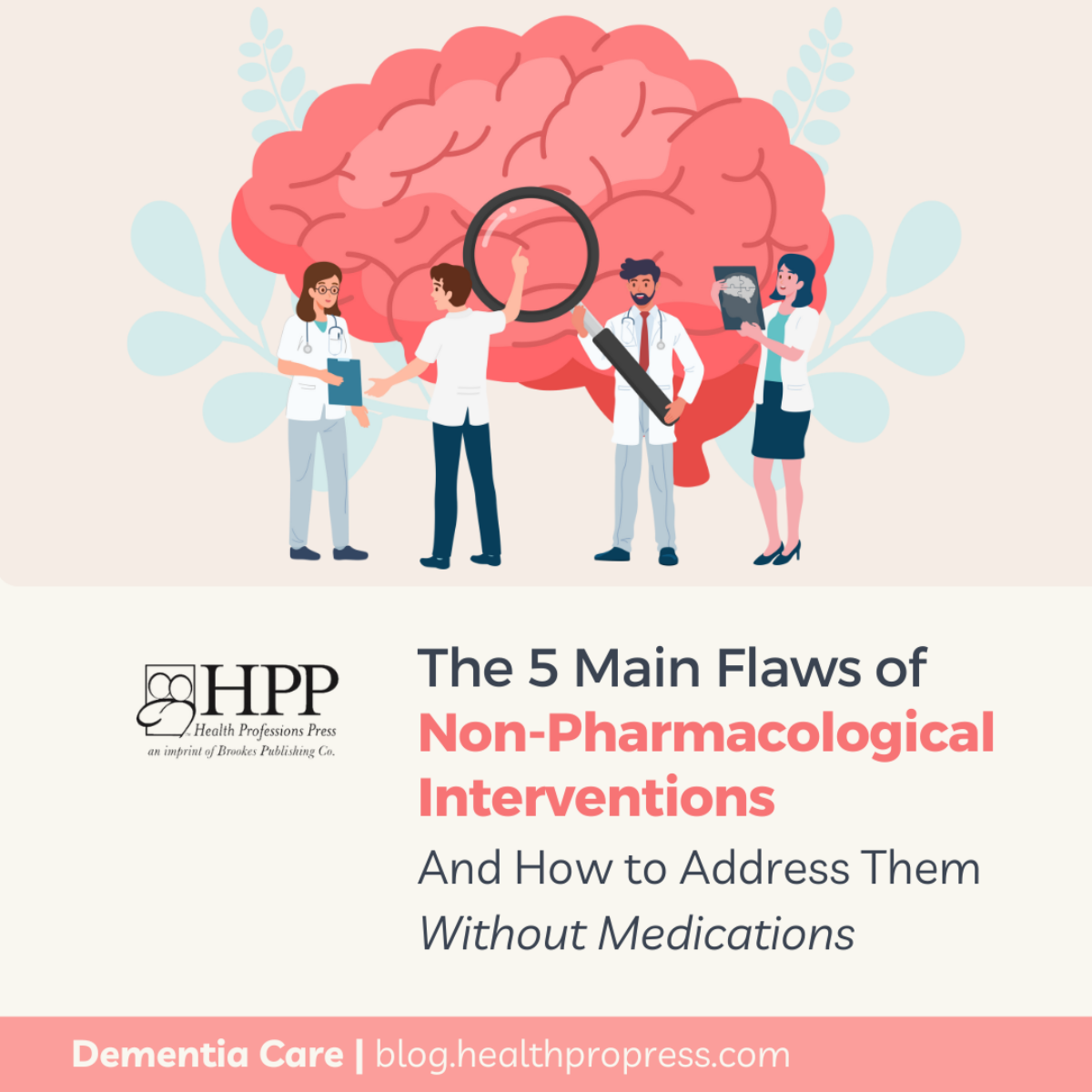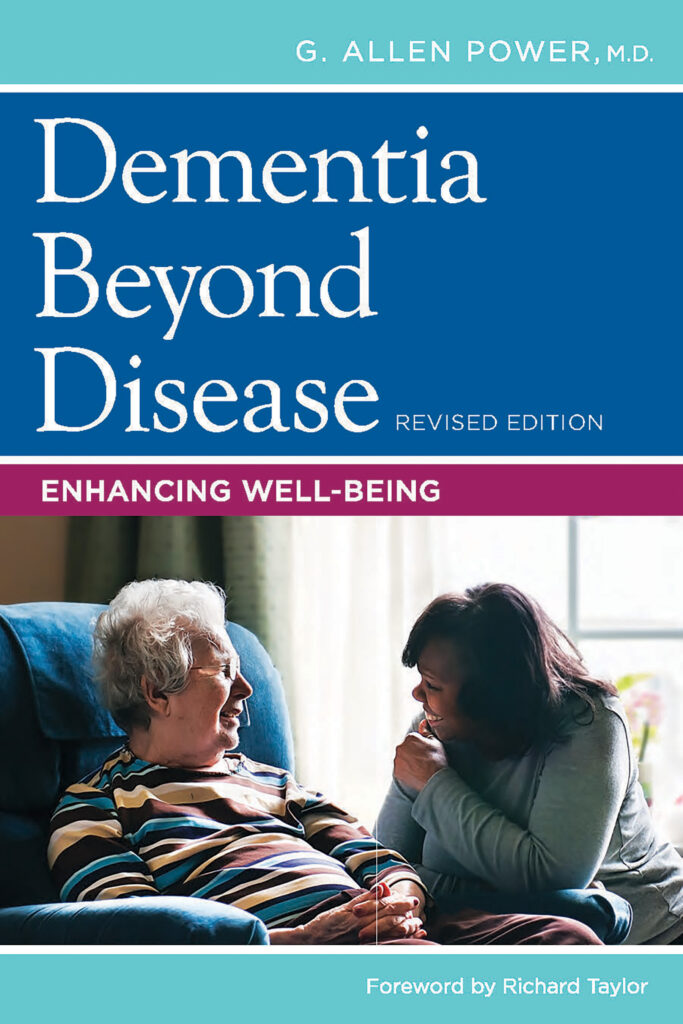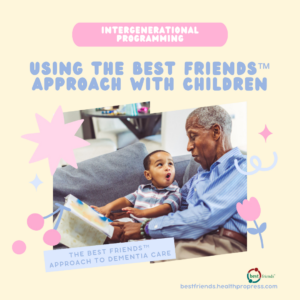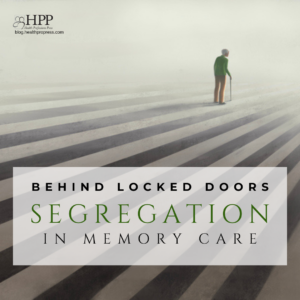
The 5 Main Flaws of Nonpharmacological Interventions (and How to Address Them Without Medication)
This post was excerpted from Dementia Beyond Disease: Enhancing Well-Being by G. Allen Power, M.D. (2017, Health Professions Press)
Why Nonpharmacological Interventions Do Not Work
This provocative heading may seem out of line for the author of a book called Dementia Beyond Drugs. Rest assured, I remain firmly rooted in the belief that most distress arises as expressions of unmet needs, and that drugs are not the answer. (For a deep dive on this, see Dementia Beyond Drugs: Changing the Culture of Care, Second Edition.) The problem lies not in that underlying philosophy, but in how it is applied.
I have two problems with the term nonpharmacological interventions: nonpharmacological and interventions. The first term defines the approach by what it is not, rather than what it is. It keeps medication use as our reference point, in spite of our rejection of that approach. Even if it does not explicitly state that a drug approach is the gold standard, it implies that it is at least a viable option, an “either–or” choice for the care partner. This is not the language that will help us shift our paradigm.
The second term brings to mind the act of “holding an intervention.” In that context, an intervention is characterized by a group of caring people who lure a friend or relative to a meeting place under false pretenses, then hold him captive while they confront him about a behavior of his that they feel is harmful, and demand that he get back on the right track.
What strikes me is how much our nonpharmacological interventions follow this same pattern. Generally they are devised and applied by a group of caring friends, relatives, or paid staff in response to a behavior that we have judged to be potentially harmful. There are often false pretenses involved, whether through distraction, diversion, or even various degrees of deception (those “little white lies” we often use to try to calm someone). Finally, we tend to remain centered on the ultimate goal of bringing the person back in line with what we feel is best for him, either not considering what it is the person truly needs or discounting his stated needs as not being “realistic.”
The 5 Main Flaws
There are many other reasons why nonpharmacological interventions fail to provide a solution to distress, including the following:
They are reactive
They respond to a moment of crisis, and while they may calm a situation, they often do not seek to understand the underlying causes and how they can be prevented in the future. For example, if a person in distress responds to being moved to a quiet place and being given a hand massage, then that approach will be applied again and again, ad infinitum, without turning our attention to how to stop the distress from recurring in the first place.
They are treated like doses of pills
“Fold washcloths once a day” or “Pet a cat three times a day before meals,” do not explore the root cause of the distress. As a result, like doses of pills, the effect of such interventions will wear off and have to be readministered.
They are not person-directed
A typical list of possible interventions is often little more than a generic algorithm to apply in a trial-and-error fashion, based on what we feel might work. We may hit on something that seems to work once or twice and stop there. What we too often fail to do is to understand the person and let her unique perspective, needs, and abilities drive our approaches. As a result, they are often devoid of meaning for the individual.
They are superimposed upon the usual living environment and approaches to care
If the living environment and approach to care are an ongoing cause of the distress, then we can never achieve lasting success.
They are not tied into domains of well-being
There are seven domains of well-being: identity, connectedness, security, autonomy, meaning, growth, and joy. These domains reject our tendency to define quality of life in terms of presence or absence of medical illness, or as a measure of our functional or cognitive abilities (i.e., what we can or cannot do). By contrast, these seven domains can exist independent of those factors. This removes the stigma of seeing a person with dementia as incapable of achieving well-being and give us a strong directive to fulfill the needs throughout everyone’s life. Indeed, these domains can be applied to any human condition, including terminal illness.
In summary
In summary, “nonpharmacological interventions” as they are most commonly applied are attempts to provide person-centered care from a biomedical mindset. As such, it is only a half-hearted paradigm shift, and so it falls short.
The fatal flaw in this approach is a focus on the distress as the problem, rather than as a sign of a larger issue. I often equate it with treating pneumonia with cough syrup. People with pneumonia often have a very bothersome cough. If a doctor sees the cough as the primary problem, then taking the cough away becomes the goal, and cough syrup is prescribed. That may quiet the cough for a while, but eventually the person will get worse, because the pneumonia is still festering and has not been properly addressed.
In a similar manner, if we see the person’s distress as the problem, then our primary goal becomes the elimination of the distress. This explains why so often we become stuck in the “pill paradigm.”
Of course, just like the cough syrup, a pill might quiet one’s distress for a while (often through some degree of sedation). We get in trouble when we conclude that we have successfully addressed the primary problem, when all we really have done is covered it up by calming the expression. And the person will eventually get worse, either because we did not address the real cause or because the pill itself is causing additional harm.
What is our primary goal?
All of the above suggests that, in spite of our efforts to reduce the use of potentially harmful medications, we are still not going about it the right way. Our federal government is right to be concerned about the overuse of such medications in people living with dementia, but a directive to reduce medication use by “X” percent by a given date (and the pledges of long-term care organizations to do so) puts the cart before the horse and sets us up for short-term gains that cannot be sustained over time.
Although I am a strong supporter of reducing our reliance on psychotropic drugs, this is not our primary goal. It is a highly desirable outcome, but it is not the place to start. Furthermore, I do not even believe that reducing distress should be our primary goal. Once again, it is a very desirable long-term outcome, but distress is the “cough,” not the “pneumonia.”
I believe that our primary goal is to enhance well-being. My decades of work on this subject have convinced me that it is the central issue in improving the lives of people with dementia, and it provides the best vehicle for creating sustainable success.
So how do we get started? Inside Dementia Beyond Disease
The 7 domains
In Dementia Beyond Disease: Enhancing Well-Being, Revised Edition I present a framework for understanding well-being based on the seven “domains.” A chapter is devoted to each of the domains of well-being, and each is explored in a variety of ways. We will look at the universal features of each domain and the intrinsic and extrinsic factors that can threaten it for a person whose cognitive abilities are changing.
Culture change
The concept of “culture change” will rear its head in this book, as we examine what needs to be done to operationalize this approach in various living environments. I will share many true stories that demonstrate the power of a well-being approach to greatly improve the lives of people who live with dementia, and their care partners as well.
A different pathway
I demonstrate a radically different pathway to understanding distress and supporting the person. I will show how the well-being framework supports a new, strengths-based approach—one that can produce more sustained success in reducing unnecessary medications than our usual “person-centered” approaches.
The true experts
The voices of people living with dementia (our “True Experts” and best teachers!) will be heard throughout the text. Ignore them at your peril!
To get started, get your copy of Dementia Beyond Disease: Enhancing Well-Being!

Dementia Beyond Disease
Enhancing Well-Being
Revised Edition
By G. Allen Power, M.D.
Revealing how drug-based interventions as well as completely holistic approaches consistently fall short of addressing and meeting the needs of people with dementia, this book offers a proactive approach—one that challenges widely accepted dementia care practices and provides a compelling new framework for developing more effective dementia services.
Through in-depth examinations of seven domains of well-being, readers will discover how current care practices erode them, and the transformative approaches that can restore them.





Add comment